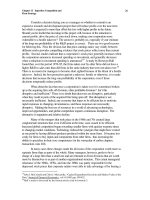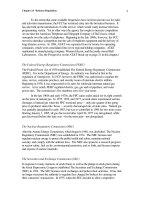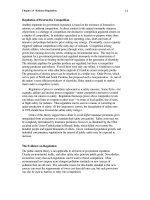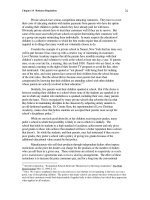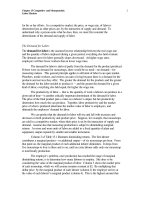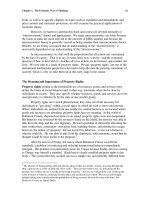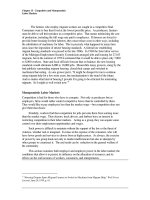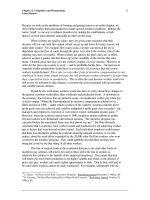Microeconomics for MBAs 46
Bạn đang xem bản rút gọn của tài liệu. Xem và tải ngay bản đầy đủ của tài liệu tại đây (39.97 KB, 10 trang )
Chapter 13 Imperfect Competition and
Firm Strategy
26
Consider a decision facing you as a manager on whether to commit to an
expensive research and development project that will reduce profits over the near term
but which is expected to more than offset this loss with higher profits in the future.
Should you be fearful that investing in this project will, because of the reduction in
current profits, drive the price of your stock down, making your corporation more
vulnerable to a hostile takeover? The answer is probably no, especially if your estimate
of the long-run profitability of the R&D project is correct. There are two good reasons
for believing this. First, the obvious fact that price-earnings ratios vary widely between
different stocks provides compelling evidence that stock prices reflect more than current
profits. Second, studies indicate that a corporation’s stock price generally increases when
the corporation announces increased spending on investment, and generally decreases
when a reduction in investment spending is announced.
19
A study by Brownyn Hall
found that, over the period 1976-85, the firms taken over by other firms did not have a
higher R&D to sales ratio than did firms in the same industry that were not taken over.
20
There is no reason for managers to become short sighted because of the threat of a hostile
takeover. Indeed, the best protection against a takeover, hostile or otherwise, is to make
decisions that increase the long-run profitability of the corporation, even if those
decisions temporarily reduce profits.
What about the fact that once a corporation is taken over it is sometimes broken
up as the acquiring firm sells off divisions, often profitable divisions? Isn’t this
disruptive and inefficient? There is no doubt that takeovers are disruptive, particularly
when they result in parts of the acquired firm being spun off. But disruption is not
necessarily inefficient. Indeed, any economy that hopes to be efficient has to motivate
rapid responses to changing circumstances, and those responses are necessarily
disruptive. Making the best use of resources in a world of advancing technologies,
improved opportunities, and global competition requires continuous disruption. The
alternative is stagnation and relative decline.
Many of the mergers that took place in the 1960s and 70s created large
conglomerate structures that, even if efficient at the time, soon ceased to be efficient.
Increased global competition began rewarding smaller firms with quicker response times
to changing market conditions. Technology reduced the synergies that might have existed
at one point by having different products produced within the same firms. It became less
costly for firms to buy inputs and components from other firms, thus increasing the
ability to specialize in their core competencies (in the vernacular of earlier chapters,
transaction costs fell).
In many cases these changes made the divisions of the corporation worth more as
separate firms than as parts of the whole. Many managers, however, prefer to be in
charge of a large firm than a small one and are reluctant to divest divisions that are worth
more by themselves or as part of another organizational structure. This extant managerial
reluctance of the 1960s, 1970s, and into the 1980s was partly responsible for the
depressed stock prices that corporate raiders were able to take advantage of by buying a
19
John J. McConnell and Chris J. Muscarella, “Capital Expenditure Decisions and Market Value of the
Firm,” Journal of Financial Economics, vol.14 (1985), pp. 399-422.
20
Hall’s study is discussed by the Jensen article cited in footnote 3.
Chapter 13 Imperfect Competition and
Firm Strategy
27
controlling interest in conglomerates and then increasing their total value by spinning off
some of their divisions.
21
Another complaint about the spinning off of divisions and downsizing that often
accompanies takeovers is that workers are laid off. The claim is made that while
stockholders may come out ahead, they do so at the expense of workers who lose their
jobs. There is evidence that hostile takeovers do result in reductions in the work force.
But the questions we want to consider are the following
• Is this a valid criticism of takeovers?
• Which workers are most likely to be laid off and how big is the cost to the
workers when compared against the gain to shareholders?
The fact that workers are laid off after hostile takeovers is consistent with the
view that these takeovers promote efficiency. The most natural thing in the world for
managers to do when sheltered against the full rigors of competition is to let the
workforce grow larger than efficiency requires. This is most evident in what are often
referred to as “bloated government bureaucracies” (a fact that is partially attributable to
the absence of the takeover option). But the same thing can and does happen in private
corporations, though generally to a lesser degree.
Economic progress occurs most rapidly when there are strong pressures to
produce the same output with less effort, to lay off workers when they are no longer
needed. This often causes dislocations in the short-run, but in the long run it increases
the availability of the most valuable resource (human effort and brainpower) to expand
output elsewhere in the economy. So a strong case can be made that one of the
advantages of the market for corporate control is that it increases the pressure on
managers to keep the size of their workforce under control. If there were an active
market for the control of government bureaucracies, where bureaucracy raiders could
profit from the savings realized by eliminating redundant government jobs, does anyone
doubt that these agencies would be run more efficiently – with far fewer workers?
Some of the efficiencies derived from hostile takeovers (and therefore some of the
benefits to corporate shareholders) are the result of workers losing their jobs. But what is
the extent of this loss, and which workers are most likely to be laid off? To address this
question, 62 hostile takeover attempts (50 of which were successful) from 1984-1986
were examined.
22
According to this study, layoffs were common, but seldom exceeded
10 percent of the workforce, and were typically far less than that. Also, it was estimated
that the probability of being laid off was 70 percent higher for white-collar workers than
for blue-collar workers. The jobs of managers, not those of workers on the line, were
21
Others have explained the advantages of moving toward more smaller and more focused firms in terms
of improved, more efficient capital markets that have made it attractive for firms to substitute reliance on
external capital markets for internal capital markets, which favor multi-division firms. See Amar Bhide,
“Reversing Corporate Diversification,” Journal of Applied Corporate Finance, Summer 1990, vol. 3
(Summer 1990), pp. 70-81.
22
See Sanjai Bhagat, Andrei Shleifer, and Robert W. Vishny, “Hostile Takeovers in the 1980s: The Return to
Corporate Specialization,” pp. 1-72 in Martin N. Bailey and Clifford Winston (eds.) Brookings Papers on
Economic Activity (Washington, DC: Brookings Institution; 1990).
Chapter 13 Imperfect Competition and
Firm Strategy
28
most at risk. In addition, layoffs at targeted firms that were not taken over were greater
(as a percentage of the workforce) than those in firms that were taken over. This suggests
that the threat of a takeover provides a strong incentive for efficiencies even when no
takeover actually occurs.
Takeover Defenses
Even if it is accepted that hostile takeovers are generally efficient, it doesn’t follow that
there should be no corporate defenses against such takeovers. Ideally there should be
some resistance to takeover offers, but not “too much.” Neither efficiency nor the
interest of stockholders would be enhanced if the managers of a corporation simply
acquiesced to the first takeover bid that offered more for the corporation’s stock than the
current price. The first bidder is not necessarily the one best able to improve the
performance of the target corporation, and therefore the first bidder is not necessarily the
one who can make the best offer. By being able to mount some defense against hostile
offers, corporate managers can stimulate an aggressive auction that results in a winning
bid that more accurately reflects the value of the corporation.
On the other hand, efficiency and the interests of shareholders can be harmed if
the defenses against takeover bids are too impenetrable. If a takeover looks impossible,
no one will make the effort to acquire control of even the most poorly managed
corporation. Also, a significant investment is involved on the part of an outsider to
determine the potential for improving the management of a target corporation and the
maximum price that can be paid for its stock and still make the takeover pay. There is
little motivation to incur the cost of this investment unless it gives those who do so a
bidding advantage. So takeover defenses that go “too far” in requiring the initial bidder
to make his information generally available can discourage takeover efforts to the point
of reducing the amount of the winning bid.
No one can know exactly what is the best defense against a hostile takeover from
the perspective of efficiency. Obviously the most efficient defense will vary from
situation to situation. But some types of defenses that managers can mount seem to be
more efficient than others.
Interestingly, there is evidence that bringing litigation against bidders increases
the amount that is ultimately paid for the stock of the target corporation, assuming that
the target corporation loses the case.
23
Managers of the target corporation can also
defend against a takeover by offering to repurchase the stock acquired by a raider at a
premiums; a practice known as greenmail. Some studies indicate that greenmail imposes
significant negative returns on shareholders of the target (repurchasing) firm, but other
studies indicate that greenmail can result in small gains for the repurchasing firm’s
shareholders.
24
Managers of the target corporation will want to be careful, however, if
23
Recall, unless otherwise indicated the studies cited are discussed in Jarrell, Brickley, and Netter, “The Market
for Corporate Control: The Empirical Evidence Since 1980.”
24
Michael C. Jensen and Richard S. Ruback, “The Market for Corporate Control: The Scientific Evidence,”
Journal of Financial Economics, vol. 11 (1983), pp. 5-50; and Wayne H. Mikkelson and Richard S.
Chapter 13 Imperfect Competition and
Firm Strategy
29
considering a policy of greenmail, since any gain to shareholders probably comes by
encouraging others to attempt a takeover in the hope of extracting greenmail. Paying
greenmail on a consistent basis is obviously not a way of promoting the long-run
profitability of a firm.
A very effective way for managers of a corporation to defend against a takeover is
through what is referred to as poison pills. A poison pill describes a rule that allows
shareholders of the target corporation to acquire additional shares at attractive prices,
which serves to dilute the stock holding of the acquiring corporation. Although there are
different types of poison pills, studies indicate that they are in general harmful to the
wealth of the target corporation’s shareholders.
25
Managers can also protect themselves against takeovers by lobbying for
legislation that reduces the chances that a takeover will be successful. Such legislation
imposes a variety of regulations on takeover activity, but the studies that have been done
suggest that, in general, they reduce shareholder wealth. The stock price of firms
typically declines relative to the general stock prices when the state in which they are
incorporated passes anti-takeover legislation.
26
Obviously, the interests of managers and those of shareholders are not in perfect
alignment in the case of takeovers. But there are possibilities for overlap that are worth
noting. A justification for a controversial severance-pay contract for top managers is
based on the desirability of reducing management opposition to takeover bids that benefit
shareholders. Top corporate managers are commonly granted what are referred to as
golden parachutes, which provide them with handsome compensation when they leave
the corporation. Such compensation can be particularly useful in cases where top
managers have to invest heavily in knowledge that is highly specific to the corporation,
and therefore worth little elsewhere. Golden parachutes can also encourage executives
to take greater risks, given that they know that they will receive a significant severance
pay package if the risks they take result in losses and they lose their jobs.
27
The argument
is that when these managers are offered generous severance pay they are less likely to
oppose a takeover offer that promotes efficiency and increases shareholder wealth.
Golden parachutes help bring the interests of top managers more in line with those of
their shareholders. But as with all incentives, care has to be exercised. Golden
Ruback, “An Empirical Analysis of the Interfirm Equity Investment Process,” Journal of Financial
Economics, vol. 14 (1985), pp. 523-553.
25
Paul H. Malatesta and Ralph A. Walkling, “Poison Pill Securities: Stockholder Wealth, Profitability, and
Ownership Structure,” Journal of Financial Economics, Journal of Finance, vol. 20 (1988), pp. 347-376.
26
Michael Ryngaert and Jeffry Netter, “Shareholder Wealth Effects of the Ohio Antitakeover Law,” Journal
of Law, Economics, and Organization, vol. 4 (1988), pp. 373-383.
27
In the absence of some form of handsome severance pay package, managers may be inclined to take too
little risk, or less risk than the stockholders may want them to take. The stockholders can have diversified
portfolios of stocks and companies over which they can spread their risks. Managers, on the other hand,
can have a fairly narrowly invested portfolio, given that their talent, one of their biggest investments, is
typically invested in one firm. Without some incentive to do otherwise, managers may be inclined to
protect their investments by investing their firm’s assets in safe ventures.
Chapter 13 Imperfect Competition and
Firm Strategy
30
parachutes should not be so lucrative that they make an executive indifferent about
keeping his or her job and losing it.
28
Like all arrangements, golden parachutes can be poorly designed and abused. It
may make sense to provide golden parachutes to no more than just the CEO of a
corporation and a few members of the top-level management team. Typically, a
significant number of managers are involved in facilitating a smooth transfer of control.
But there is no reason to extend golden parachutes to managers not involved in such a
transfer. Also, while golden parachutes can be too stingy to promote the shareholder
interests, they can also be too generous from the shareholders’ perspective. Ideally,
golden parachutes will be provided only to those managers whose responsibilities are
relevant to a takeover, and the severance compensation provided will be tied to premiums
in share prices generated by the takeover.
There is at least tentative support for the proposition that golden parachutes
promote the interests of shareholders. According to one study of corporations that
adopted golden parachutes, corporate stock increases an average of about 3 percent when
the adoption is announced. One interpretation of this result is that the golden parachutes
increased the connection between the interests of shareholders and managers. It is
possible, of course, that part of the increased stock value resulted from the belief that the
announcement indicated that management was expecting a takeover bid and wanted to
protect themselves against it.
* * * * *
The primary point of this chapter is that many so-called “hostile” takeovers are
not really hostile, at least not from the perspective of the owners of the corporation being
taken over. Throughout the chapter, we have suggested that hostile takeovers promote
efficiency by encouraging managers to behave as good agents for their stockholders.
The efficiency of hostile takeovers will surely remain subject to debate. And
certainly no serious person would argue that all hostile (or even friendly) takeovers are
efficient. Mistakes are made in the market for corporate control that, after the fact, leave
all parties worse off. So the debate over hostile takeovers will continue, and so will
hostile takeovers. Of course, from the perspective of most managers, the fact that hostile
takeovers will continue is more important than the debate over their efficiency. But the
best way for managers to protect themselves against unwelcome attention in the takeover
market is to do a good job enhancing the long-term profitability of the firm. And this is
probably the best argument in support of the efficiency of hostile takeovers. Even if
every hostile takeover that is attempted was itself inefficient, the fact that they can and do
occur creates a strong incentive for managers to manage firms efficiently on behalf of
their shareholders.
28
For a more detailed discussion of golden parachutes, see Jensen, “The Market for Corporate Control.”
